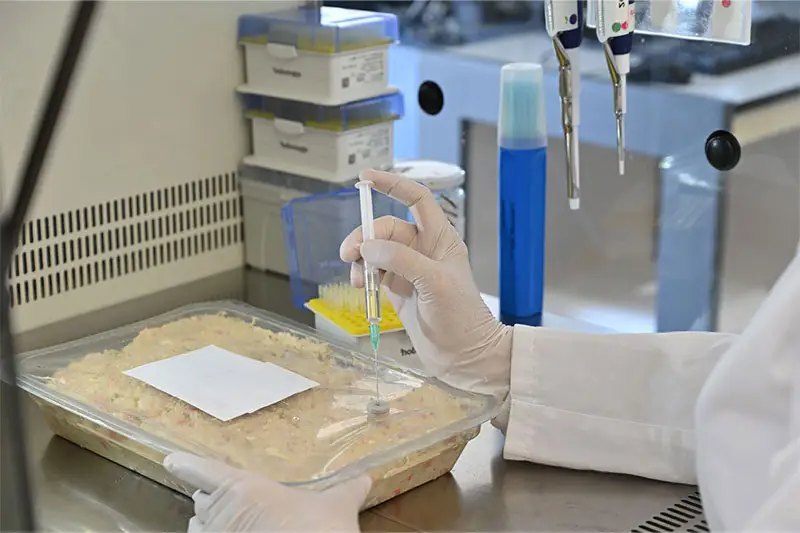ISO 21151 Detection of Staphylococcus Aureus in Cosmetics Testing
The detection and control of microbial contamination in cosmetics is essential to ensure consumer safety, comply with international standards, and maintain brand reputation. Among the various microorganisms that can pose risks to cosmetic products, Staphylococcus aureus stands out due to its potential to cause skin infections and its ability to survive under harsh conditions.
The International Organization for Standardization (ISO) has developed ISO 21151:2018, which provides a standardized method for the detection of Staphylococcus aureus. This standard is widely recognized across the cosmetic industry and ensures that laboratories perform tests in a consistent manner. The test involves several steps including sample preparation, inoculation onto selective media, incubation, and finally, confirmation using biochemical methods.
The process begins with the collection of samples from various stages of production or finished products. Samples are then processed according to ISO 21151 guidelines which specify the dilution and plating techniques used to enhance detection sensitivity. After inoculation onto chromogenic medium that selectively supports Staphylococcus aureus, incubation at optimal conditions allows for colony growth.
The next step is critical confirmation through biochemical identification tests such as catalase test, coagulase test, and DNA fingerprinting if necessary. These confirmatory steps help eliminate false positives which might arise from other similar microorganisms present in the sample.
Accurate detection of Staphylococcus aureus is vital not only for compliance with regulations but also to protect consumers by ensuring that products do not contain harmful bacteria. Regulatory bodies like the European Commission and the US FDA recommend following this standard procedure to ensure product safety.
The importance of this testing cannot be overstated, especially given recent incidents involving contaminated cosmetic products leading to recalls and public health concerns. By adhering strictly to ISO 21151 guidelines, laboratories can provide reliable results that reassure both manufacturers and regulators about the purity and quality of their cosmetics.
Our laboratory has extensive experience in executing these tests with precision and accuracy. We employ highly trained technicians equipped with state-of-the-art equipment capable of detecting even trace amounts of Staphylococcus aureus. Our rigorous quality control measures ensure that every result meets the stringent requirements set forth by ISO 21151.
In summary, implementing ISO 21151 for the detection of Staphylococcus aureus in cosmetics is crucial not only for regulatory compliance but also to safeguard public health. Our expertise and adherence to this standard allow us to deliver trustworthy results that contribute significantly towards maintaining high standards within the cosmetic industry.
Benefits
The implementation of ISO 21151 for detecting Staphylococcus aureus offers numerous benefits particularly in terms of enhancing product safety and regulatory compliance:
- Enhanced Product Safety: By ensuring that no harmful bacteria like Staphylococcus aureus are present in cosmetics, manufacturers can protect consumers from potential health risks.
- Regulatory Compliance: Adhering to internationally recognized standards such as ISO 21151 helps businesses meet legal requirements and avoid penalties associated with non-compliance.
- Brand Reputation: Consistently delivering safe products strengthens a company's reputation, fostering trust among customers and stakeholders.
- Cost Efficiency: Early detection of contaminants through rigorous testing reduces the likelihood of costly recalls later down the line.
In essence, integrating ISO 21151 into cosmetic manufacturing processes not only ensures compliance with global regulations but also contributes positively to brand image and operational efficiency.
Customer Impact and Satisfaction
The detection of Staphylococcus aureus in cosmetics through ISO 21151 plays a pivotal role in enhancing customer satisfaction by ensuring product safety. For many consumers, especially those with sensitive skin or compromised immune systems, knowing that their cosmetic products are free from harmful bacteria provides peace of mind.
Absence of Staphylococcus aureus in cosmetics can lead to fewer instances of adverse reactions such as rashes, infections, and other dermatological issues. This aligns with the broader goal of enhancing overall well-being among consumers who rely on these products for personal care.
In addition to direct health benefits, customers value brands that demonstrate a commitment to quality and safety. By leveraging ISO 21151, companies can position themselves as leaders in product integrity, thereby attracting more loyal customers willing to support such practices.
Moreover, adhering to these stringent standards showcases corporate responsibility towards public health, which is increasingly important given heightened awareness regarding product safety across various sectors including cosmetics. Such actions foster a culture of trust and reliability that ultimately contributes positively to brand loyalty and market reputation.
Competitive Advantage and Market Impact
The adoption of ISO 21151 for Staphylococcus aureus detection offers significant competitive advantages in the cosmetic industry. In an era where consumers are becoming more discerning about product quality, adhering to this international standard can set a company apart from its competitors.
Firstly, it demonstrates a commitment to maintaining high standards of hygiene and safety throughout all stages of production. This proactive approach not only enhances consumer trust but also builds long-term relationships based on reliability and integrity.
Secondly, compliance with ISO 21151 ensures that products consistently meet stringent quality criteria, thereby reducing the risk of recalls or withdrawals due to contamination issues. Such incidents can have severe financial repercussions for any business involved in cosmetics manufacturing.
Furthermore, companies that invest in robust testing protocols like those outlined by ISO 21151 often enjoy faster access to new markets where regulatory requirements are stringent. This timely entry into emerging markets can significantly boost sales and market share.
The ability to provide accurate and reliable results through ISO 21151 testing also positions a company as an industry leader in terms of innovation and technological advancement within the cosmetic sector. As regulations evolve, those who stay ahead by continuously improving their testing methodologies will continue to gain competitive edge over others lagging behind.
In conclusion, integrating ISO 21151 into cosmetic manufacturing processes is more than just a compliance issue—it represents an opportunity for businesses to enhance their reputation, protect consumers' health, and secure market leadership. By prioritizing this standard, companies can achieve sustainable growth while contributing positively towards public health goals.





